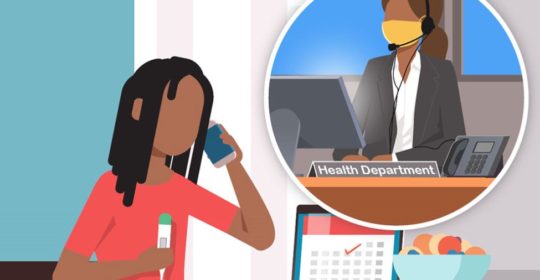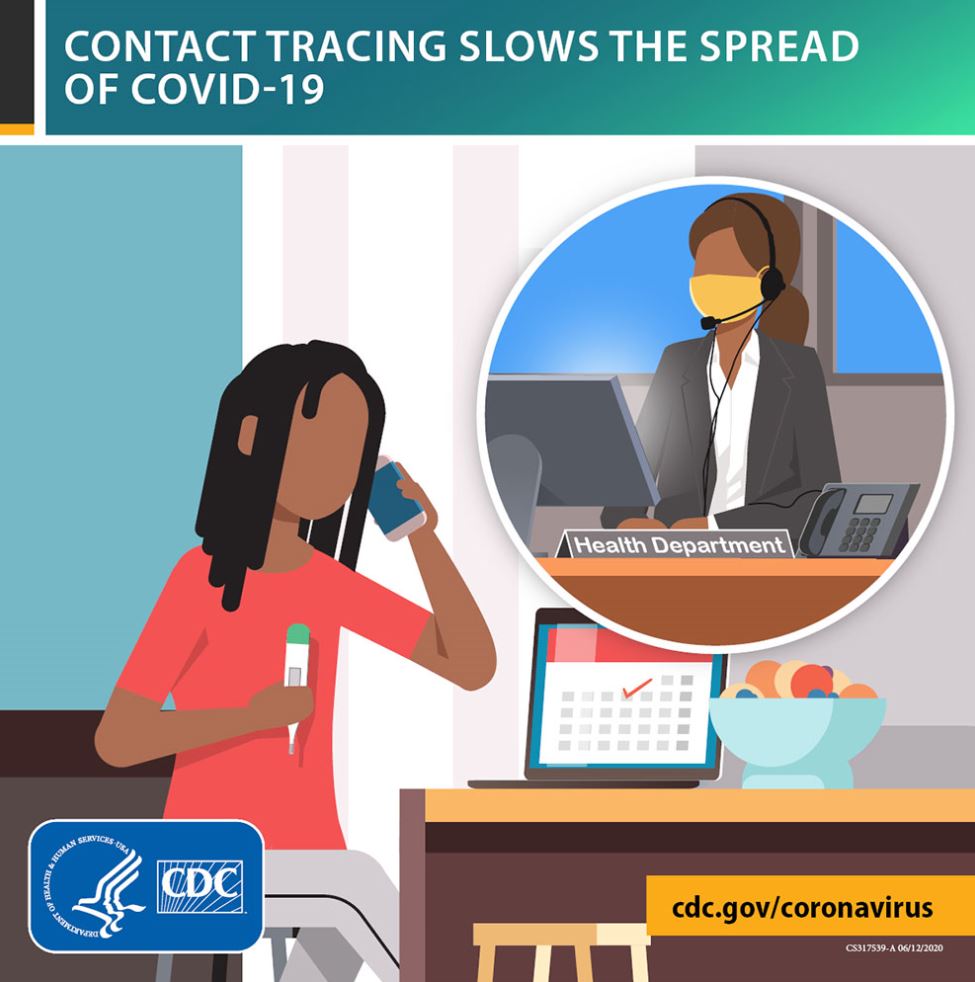
COVID-19: Contact Tracing

Contact tracing is key to slowing the spread of COVID-19 and helps keep you, your family, and your community safe.
Contact tracing is used by health departments to prevent the spread of infectious disease. In general, contact tracing involves identifying people who have an infectious disease (cases) and people who they came in contact with (contacts) and working with them to interrupt disease spread. This includes asking people with COVID-19 to isolate and their contacts to quarantine
Contact tracing for COVID-19 typically involves
- Interviewing people with COVID-19 to identify everyone they had close contact with during the time they may have been infectious
- Notifying contacts of their potential exposure
- Referring contacts for testing
- Monitoring contacts for signs and symptoms of COVID-19
- Connecting contacts with services they might need during the self-quarantine period
To prevent the further spread of disease, people who had contact with someone with COVID-19 are encouraged to stay home and maintain social distance (at least 6 feet) from others until 14 days after their last exposure to a person with COVID-19. Contacts should monitor themselves by checking their temperature twice daily and watching for symptoms of COVID-19.
Quick Fact
Contact tracing can stop the spread of COVID-19 with these key steps:- Quickly identifying anyone with COVID-19 and their contacts
- Asking them to isolate or self-quarantine
- Working with public health staff to monitor themselves for illness
Contact tracing steps
Generally, contact tracing includes the following steps:
- Case investigation: Public health staff work with a patient to help them recall everyone they have had close contact with during the time they may have been infectious.
- Contact tracing: Public health staff begin contact tracing by notifying exposed people (contacts) of their potential exposure as rapidly and sensitively as possible, not revealing the infected patient’s identity.
- Contact support: Contacts are provided with education, information, and support to help them understand their risk, what they should do to separate themselves from others who are not exposed, and how to monitor themselves for illness. In addition, they are informed of the possibility that they could spread the infection to others even if they do not feel ill.
- Self-quarantine: Contacts are encouraged to stay home, monitor their health, and maintain social distance (at least 6 feet) from others until 14 days after their last exposure to the infected patient, in case they also become ill.
Did you know?
Contact tracing is a core disease control activity. It has been used for decades by state and local health departments to slow or stop the spread of infectious disease.
What a person diagnosed with COVID-19 can expect to happen during contact tracing
If you are diagnosed with COVID-19, a public health worker may call you to check-in on your health, discuss who you’ve been in contact with, and ask where you spent time while you may have been infectious and able to spread COVID-19 to others. You will also be asked to stay at home and self-isolate, if you are not doing so already.
- Your name will not be revealed to those you may have exposed, even if they ask.
- Self-isolation means staying at home in a specific room away from other people and pets and using a separate bathroom, if possible.
- Self-isolation helps slow the spread of COVID-19 and can help keep your family, friends, neighbors, and others you may come in contact with healthy.
- If you need support or assistance while self-isolating, your health department or community organizations may be able to provide assistance.
- Symptoms of COVID-19 can include fever or chills, cough, shortness of breath or difficulty breathing, fatigue, muscle or body aches, headache, new loss of taste or smell, sore throat, congestion or runny nose, nausea or vomiting, and diarrhea. If your symptoms worsen or become severe, you should seek medical care. Severe symptoms include trouble breathing, persistent pain or pressure in the chest, confusion, inability to wake or stay awake, or bluish lips or face.
What a close contact can expect to happen during contact tracing
If you have been in close contact with someone who has COVID-19, a public health worker might contact you to inform you that you’ve been exposed to COVID-19.
You should stay at home and self-quarantine for 14 days, starting from the last day you were possibly exposed to COVID-19. The public health worker will help identify the dates of your self-quarantine. They can also provide resources about COVID-19 testing in your area.
- Self-quarantine means staying home, monitoring your health, and maintaining social distancing (at least 6 feet) from others at all times.
- If you need to be around other people or animals in or outside of the home, wear a cloth face covering. This will help protect the people around you.
- If you need support or assistance with self-quarantine, your health department or community organizations may be able to provide assistance.
You should take your temperature twice a day, watch for symptoms of COVID-19, and notify your health department if you have symptoms. You should also notify people you had close contact with recently if you become ill, so they can monitor their health. If your symptoms worsen or become severe, you should seek medical care. Severe symptoms include trouble breathing, persistent pain or pressure in the chest, confusion, inability to wake or stay awake, or bluish lips or face.
Source:
- CDC


Most Commented